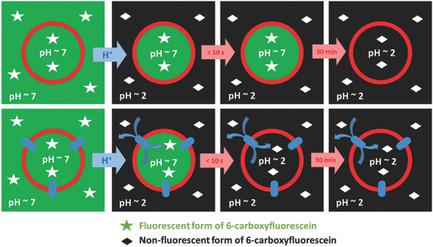当前位置:
X-MOL 学术
›
Macromol. Rapid Commun.
›
论文详情
Our official English website, www.x-mol.net, welcomes your feedback! (Note: you will need to create a separate account there.)
Imaging Proton Transport in Giant Vesicles through Cyclic Peptide–Polymer Conjugate Nanotube Transmembrane Ion Channels
Macromolecular Rapid Communications ( IF 4.6 ) Pub Date : 2018-02-16 , DOI: 10.1002/marc.201700831 Jason G. Binfield 1 , Johannes C. Brendel 1 , Neil R. Cameron 2, 3 , Ahmed M. Eissa 2, 3, 4 , Sébastien Perrier 1, 5, 6
Macromolecular Rapid Communications ( IF 4.6 ) Pub Date : 2018-02-16 , DOI: 10.1002/marc.201700831 Jason G. Binfield 1 , Johannes C. Brendel 1 , Neil R. Cameron 2, 3 , Ahmed M. Eissa 2, 3, 4 , Sébastien Perrier 1, 5, 6
Affiliation

|
Since their discovery in 1993, interest in various aspects of cyclic peptides (CPs) has expanded rapidly. Of particular note is their potential to form artificial ion channels in lipid membranes, an attractive characteristic in supramolecular chemistry and biological research. The design and synthesis of cyclic peptide–polymer conjugates (CPPCs) that can self‐assemble within lipid bilayers into nanotubes, mimicking naturally occurring membrane channels and pores, has been reported. However, methods that allow direct detection of the transport process with high levels of certainty are still lacking. This work focuses on the development of a simple but reliable approach to verify and quantify proton transport across a bilayer membrane. Giant unilamellar vesicles (GUVs) are created via the electroformation method and CPPCs are incorporated in GUV membranes at varying concentrations (0–10%). Confocal fluorescence microscopy is used to demonstrate full inclusion of fluorescein‐labeled CPPCs in the GUV membranes. The pH‐sensitive dye carboxyfluorescein is encapsulated within the water pool of the GUVs and used as an indicator of proton transport. This assay is versatile and can be exploited on other existing proton transporter systems, providing a consistent tool to compare their performances. It should also aid the development of novel antineoplastics and drug delivery systems.
中文翻译:

通过环肽-聚合物共轭纳米管跨膜离子通道成像在大囊泡中的质子运输。
自从1993年发现以来,人们对环肽(CP)的各个方面的兴趣迅速增长。特别值得注意的是它们在脂质膜上形成人工离子通道的潜力,这是超分子化学和生物学研究的一个吸引人的特征。据报道,环肽-聚合物共轭物(CPPC)的设计和合成可以在脂质双层中自组装成纳米管,模仿天然存在的膜通道和孔。但是,仍然缺少能够高度确定性地直接检测运输过程的方法。这项工作的重点是开发一种简单而可靠的方法来验证和量化跨双层膜的质子传输。巨大的单层囊泡(GUV)是通过电形成法产生的,CPPC以不同的浓度(0-10%)掺入到GUV膜中。共聚焦荧光显微镜用于证明GUV膜中完全包含了荧光素标记的CPPC。pH敏感染料羧基荧光素被封装在GUV的水池中,并用作质子传输的指示剂。该测定法用途广泛,可以在其他现有的质子转运系统上使用,从而提供了一个比较其性能的一致工具。它还应有助于新型抗肿瘤药和药物递送系统的开发。pH敏感染料羧基荧光素被封装在GUV的水池中,并用作质子传输的指示剂。该测定法用途广泛,可以在其他现有的质子转运系统上使用,从而提供了一个比较其性能的一致工具。它还应有助于新型抗肿瘤药和药物递送系统的开发。pH敏感染料羧基荧光素被封装在GUV的水池中,并用作质子传输的指示剂。该测定法用途广泛,可以在其他现有的质子转运系统上使用,从而提供了一个比较其性能的一致工具。它还应有助于新型抗肿瘤药和药物递送系统的开发。
更新日期:2018-02-16
中文翻译:

通过环肽-聚合物共轭纳米管跨膜离子通道成像在大囊泡中的质子运输。
自从1993年发现以来,人们对环肽(CP)的各个方面的兴趣迅速增长。特别值得注意的是它们在脂质膜上形成人工离子通道的潜力,这是超分子化学和生物学研究的一个吸引人的特征。据报道,环肽-聚合物共轭物(CPPC)的设计和合成可以在脂质双层中自组装成纳米管,模仿天然存在的膜通道和孔。但是,仍然缺少能够高度确定性地直接检测运输过程的方法。这项工作的重点是开发一种简单而可靠的方法来验证和量化跨双层膜的质子传输。巨大的单层囊泡(GUV)是通过电形成法产生的,CPPC以不同的浓度(0-10%)掺入到GUV膜中。共聚焦荧光显微镜用于证明GUV膜中完全包含了荧光素标记的CPPC。pH敏感染料羧基荧光素被封装在GUV的水池中,并用作质子传输的指示剂。该测定法用途广泛,可以在其他现有的质子转运系统上使用,从而提供了一个比较其性能的一致工具。它还应有助于新型抗肿瘤药和药物递送系统的开发。pH敏感染料羧基荧光素被封装在GUV的水池中,并用作质子传输的指示剂。该测定法用途广泛,可以在其他现有的质子转运系统上使用,从而提供了一个比较其性能的一致工具。它还应有助于新型抗肿瘤药和药物递送系统的开发。pH敏感染料羧基荧光素被封装在GUV的水池中,并用作质子传输的指示剂。该测定法用途广泛,可以在其他现有的质子转运系统上使用,从而提供了一个比较其性能的一致工具。它还应有助于新型抗肿瘤药和药物递送系统的开发。


























 京公网安备 11010802027423号
京公网安备 11010802027423号